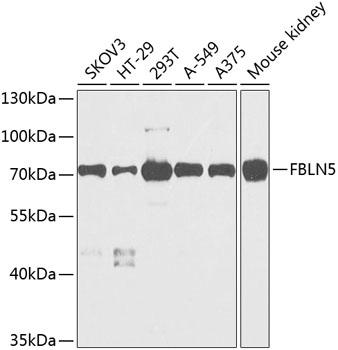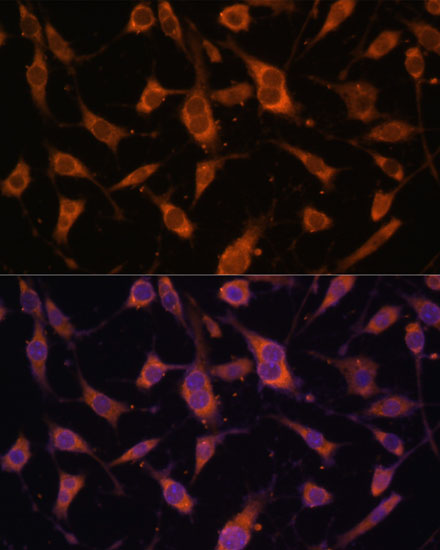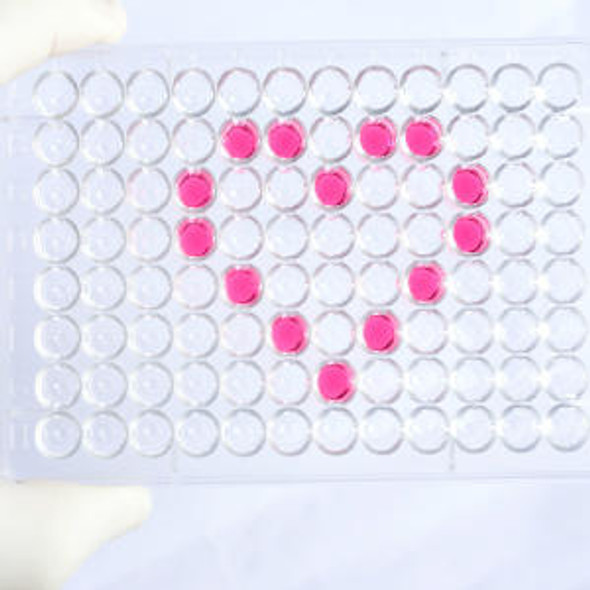Cell Biology Antibodies 12
Anti-Fibulin-5 Antibody (CAB9961)
- SKU:
- CAB9961
- Product Type:
- Antibody
- Applications:
- WB
- Reactivity:
- Human
- Reactivity:
- Mouse
- Host Species:
- Rabbit
- Isotype:
- IgG
- Research Area:
- Cell Biology
Description
| Antibody Name: | Anti-Fibulin-5 Antibody |
| Antibody SKU: | CAB9961 |
| Antibody Size: | 20uL, 50uL, 100uL |
| Application: | WB IF |
| Reactivity: | Human, Mouse |
| Host Species: | Rabbit |
| Immunogen: | Recombinant fusion protein containing a sequence corresponding to amino acids 199-448 of human FBLN5 (NP_006320.2). |
| Application: | WB IF |
| Recommended Dilution: | WB 1:500 - 1:2000 IF 1:50 - 1:100 |
| Reactivity: | Human, Mouse |
| Positive Samples: | SKOV3, HT-29, 293T, A-549, A375, Mouse kidney |
| Immunogen: | Recombinant fusion protein containing a sequence corresponding to amino acids 199-448 of human FBLN5 (NP_006320.2). |
| Purification Method: | Affinity purification |
| Storage Buffer: | Store at -20'C. Avoid freeze / thaw cycles. Buffer: PBS with 0.02% sodium azide, 50% glycerol, pH7.3. |
| Isotype: | IgG |
| Sequence: | NEDG RSCQ DVNE CATE NPCV QTCV NTYG SFIC RCDP GYEL EEDG VHCS DMDE CSFS EFLC QHEC VNQP GTYF CSCP PGYI LLDD NRSC QDIN ECEH RNHT CNLQ QTCY NLQG GFKC IDPI RCEE PYLR ISDN RCMC PAEN PGCR DQPF TILY RDMD VVSG RSVP ADIF QMQA TTRY PGAY YIFQ IKSG NEGR EFYM RQTG PISA TLVM TRPI KGPR EIQL DLEM ITVN TVIN FRGS SVIR LRIY VSQY PF |
| Gene ID: | 10516 |
| Uniprot: | Q9UBX5 |
| Cellular Location: | Secreted, extracellular matrix, extracellular space |
| Calculated MW: | 50kDa |
| Observed MW: | 72kDa |
| Synonyms: | FBLN5, ADCL2, ARCL1A, ARMD3, DANCE, EVEC, FIBL-5, HNARMD, UP50, fibulin-5 |
| Background: | The protein encoded by this gene is a secreted, extracellular matrix protein containing an Arg-Gly-Asp (RGD) motif and calcium-binding EGF-like domains. It promotes adhesion of endothelial cells through interaction of integrins and the RGD motif. It is prominently expressed in developing arteries but less so in adult vessels. However, its expression is reinduced in balloon-injured vessels and atherosclerotic lesions, notably in intimal vascular smooth muscle cells and endothelial cells. Therefore, the protein encoded by this gene may play a role in vascular development and remodeling. Defects in this gene are a cause of autosomal dominant cutis laxa, autosomal recessive cutis laxa type I (CL type I), and age-related macular degeneration type 3 (ARMD3). |
| UniProt Protein Function: | FBLN5: Promotes adhesion of endothelial cells through interaction of integrins and the RGD motif. Could be a vascular ligand for integrin receptors and may play a role in vascular development and remodeling. Defects in FBLN5 are the cause of cutis laxa, autosomal dominant, type 2 (ADCL2). A connective tissue disorder characterized by loose, hyperextensible skin with decreased resilience and elasticity leading to a premature aged appearance. Face, hands, feet, joints, and torso may be differentially affected. Additional variable clinical features are gastrointestinal diverticula, hernia, and genital prolapse. Rare manifestations are pulmonary artery stenosis, aortic aneurysm, bronchiectasis, and emphysema. Defects in FBLN5 are a cause of cutis laxa, autosomal recessive, type 1A (ARCL1A). A connective tissue disorder characterized by loose, hyperextensible skin with decreased resilience and elasticity leading to a premature aged appearance. Face, hands, feet, joints, and torso may be differentially affected. The clinical spectrum of autosomal recessive cutis laxa is highly heterogeneous with respect to organ involvement and severity. Type I autosomal recessive cutis laxa is a specific, life-threatening disorder with organ involvement, lung atelectasis and emphysema, diverticula of the gastrointestinal and genitourinary systems, and vascular anomalies. Associated cranial anomalies, late closure of the fontanel, joint laxity, hip dislocation, and inguinal hernia have been observed but are uncommon. Defects in FBLN5 are the cause of age-related macular degeneration type 3 (ARMD3). ARMD is a multifactorial disease and the most common cause of irreversible vision loss in the developed world. In most patients, the disease is manifest as ophthalmoscopically visible yellowish accumulations of protein and lipid (known as drusen) that lie beneath the retinal pigment epithelium and within an elastin-containing structure known as Bruch membrane. Belongs to the fibulin family. |
| UniProt Protein Details: | Protein type:Secreted; Secreted, signal peptide Chromosomal Location of Human Ortholog: 14q32.1 Cellular Component: extracellular matrix; extracellular region; extracellular space; proteinaceous extracellular matrix Molecular Function:calcium ion binding; integrin binding; protein binding; protein C-terminus binding; protein homodimerization activity Biological Process: cell-matrix adhesion; elastic fiber assembly; extracellular matrix organization and biogenesis; regulation of cell growth; secretion Disease: Cutis Laxa, Autosomal Dominant 2; Cutis Laxa, Autosomal Recessive, Type Ia; Macular Degeneration, Age-related, 3 |
| NCBI Summary: | The protein encoded by this gene is a secreted, extracellular matrix protein containing an Arg-Gly-Asp (RGD) motif and calcium-binding EGF-like domains. It promotes adhesion of endothelial cells through interaction of integrins and the RGD motif. It is prominently expressed in developing arteries but less so in adult vessels. However, its expression is reinduced in balloon-injured vessels and atherosclerotic lesions, notably in intimal vascular smooth muscle cells and endothelial cells. Therefore, the protein encoded by this gene may play a role in vascular development and remodeling. Defects in this gene are a cause of autosomal dominant cutis laxa, autosomal recessive cutis laxa type I (CL type I), and age-related macular degeneration type 3 (ARMD3). [provided by RefSeq, Jul 2008] |
| UniProt Code: | Q9UBX5 |
| NCBI GenInfo Identifier: | 12643876 |
| NCBI Gene ID: | 10516 |
| NCBI Accession: | Q9UBX5.1 |
| UniProt Secondary Accession: | Q9UBX5,O75966, Q6IAL4, Q6UWA3, |
| UniProt Related Accession: | Q9UBX5 |
| Molecular Weight: | 50,180 Da |
| NCBI Full Name: | Fibulin-5 |
| NCBI Synonym Full Names: | fibulin 5 |
| NCBI Official Symbol: | FBLN5 |
| NCBI Official Synonym Symbols: | EVEC; UP50; ADCL2; ARMD3; DANCE; ARCL1A; FIBL-5; HNARMD |
| NCBI Protein Information: | fibulin-5 |
| UniProt Protein Name: | Fibulin-5 |
| UniProt Synonym Protein Names: | Developmental arteries and neural crest EGF-like protein; Dance; Urine p50 protein; UP50 |
| Protein Family: | Fibulin |
| UniProt Gene Name: | FBLN5 |
| UniProt Entry Name: | FBLN5_HUMAN |
View AllClose





![Anti-Human Fibulin-4 [5G11] In Vivo Antibody - Low Endotoxin Anti-Human Fibulin-4 [5G11] In Vivo Antibody - Low Endotoxin](https://cdn11.bigcommerce.com/s-rd6ounxcu2/images/stencil/590x590/products/78774/83956/anti-human-fibulin-4-5g11-in-vivo-antibody-low-endotoxin__88058__68797.1706545351.jpg?c=1)


